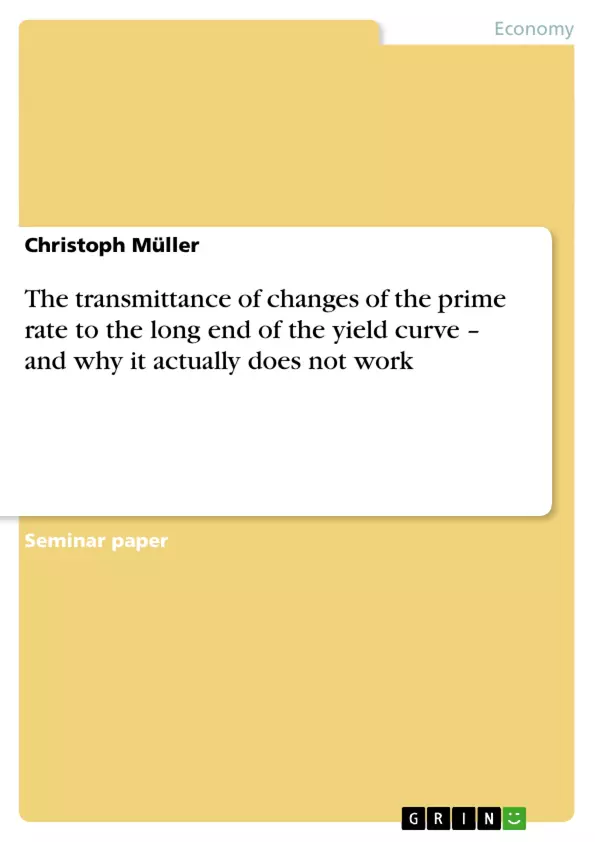In February 2005, Fed’s Chairman Alan Greenspan wondered why the long end of the yield curve did not show any reaction to the hiking prime rate. Normally, a hiking prime rate gets through the complex transmittance-mechanism to the long end of a yield curve. But in this cycle since June 2004, nothing changed at the long end. An explanation via the classic interest theories does not come to a satisfiying result, so the situation must be explained by the actual circumstances.
The main reason is a very high liquidity which has its origin in the last economic cycle. The excessive investments in 1999 and 2000 still keep the enterprises busy. They do not invest in fixed assets, which would mean a higher capital demand, but on the capital market; and they pay back their debts, which also leads to a falling yield.
The liquidity supply from east asia causes a high demand for US-$ - bonds as well. China for example holds more than one trillion US-$ as monetary reserve to keep their exchange rate low.
A combination of many more, different facts, which deserve closer attention, lead to the answer to Greenspan’s conundrum.
Inhaltsverzeichnis (Table of Contents)
- Introduction
- The Yield Curve: Basics
- Theories of the Transmittance in the Yield Curve
- Fisher's Theory of Interest
- Hicks' Liquidity-Preference-Theory
- Culbertson's Segmentation Theory
- Preferred-Habitat-Theory
- Summary
- Description of the Actual Situation
- Reasons for the Deviation from the Theories
- Expectation-Determined Factors
- Liquidity Factors
- Structural Factors
- The Comprehension of the Central Bank
- Conclusion
Zielsetzung und Themenschwerpunkte (Objectives and Key Themes)
This study explores the discrepancy between changes in the short-term prime rate and the lack of corresponding reaction in the long end of the yield curve. The work aims to explain this phenomenon, which was observed by Alan Greenspan in 2005, by examining the factors contributing to this deviation from traditional economic theories.
- The transmission mechanism of interest rate changes from the short end to the long end of the yield curve
- The influence of liquidity on the yield curve
- The impact of structural factors on the yield curve
- The role of central bank policy in shaping the yield curve
- The limitations of classic interest rate theories in explaining contemporary market behavior
Zusammenfassung der Kapitel (Chapter Summaries)
- Introduction: This chapter introduces the central question of the study: why does the long end of the yield curve not respond to changes in the short-term prime rate? It highlights the disconnect between the Federal Reserve's expectations for its policy and the actual observed behavior of the yield curve.
- The Yield Curve: Basics: This chapter provides a definition of the yield curve and explains its fundamental relationship to interest rates, bond markets, and the demand and supply of capital. It clarifies how central banks, specifically the Federal Reserve, influence the yield curve through their prime rate policy.
- Theories of the Transmittance in the Yield Curve: This chapter explores various economic theories that attempt to explain the transmission mechanism of interest rate changes from the short end to the long end of the yield curve. It focuses on prominent theories such as Fisher's Theory of Interest, Hicks' Liquidity-Preference-Theory, Culbertson's Segmentation Theory, and the Preferred-Habitat-Theory.
- Description of the Actual Situation: This chapter presents the specific observed situation in 2005 and 2007, highlighting the lack of response in the long-term rates to several prime rate hikes by the Federal Reserve. It provides data and examples to demonstrate the divergence between theoretical expectations and market reality.
- Reasons for the Deviation from the Theories: This chapter investigates the factors that contribute to the observed deviation from the predictions of classic interest rate theories. It explores aspects such as expectation-determined factors, liquidity factors, structural factors, and the comprehension of the central bank.
Schlüsselwörter (Keywords)
This work focuses on the interplay of various factors influencing the yield curve, particularly its lack of responsiveness to short-term interest rate changes. Key concepts include the prime rate, liquidity, structural factors, central bank policy, and the limitations of classic interest rate theories in explaining contemporary market behavior.
- Quote paper
- Christoph Müller (Author), 2007, The transmittance of changes of the prime rate to the long end of the yield curve – and why it actually does not work, Munich, GRIN Verlag, https://www.grin.com/document/86020



